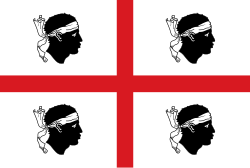This article has multiple issues. Please help improve it or discuss these issues on the talk page. (Learn how and when to remove these messages)
|
| The four Moors | |
| Use | Civil and state flag |
|---|---|
| Proportion | 3:5 or 2:3 |
| Adopted | Used since 1281; current version adopted on 15 April 1999 |
| Design | Four moors head in St. George's cross |
The flag of Sardinia,[a] also referred to as the Four Moors,[b] represents and symbolizes the island of Sardinia (Italy) and its people. It was also the historical flag and coat of arms of the Aragonese, then Spanish, and later Savoyard Kingdom of Sardinia. It was first officially adopted by the autonomous region in 1950 with a revision in 1999, describing it as a "white field with a red cross and a bandaged Moor's head facing away from the hoist (the edge close to the mast) in each quarter" (Regional Law 15 April 1999, n. 10, Art. 1).[6]
The flag is composed of the St George's Cross and four heads of Moors, which in the past may not have been forehead bandaged but blindfolded and turned towards the hoist. But already well-preserved pictures from the 16th century clearly show a forehead bandage (see gallery below). The most accepted hypothesis is that the heads represented the heads of Moorish princes defeated by the Aragonese, as for the first time they appeared in the 13th-century seals of the Crown of Aragon – although with a beard and no bandage, contrary to the Moors of the Sardinian flag, which appeared for the first time in a manuscript of the second half of the 14th century.
- ^ "I Quattro Mori: La storia della bandiera sarda". 4 June 2020.
- ^ "I 4 mori perdono la benda la Regione modifica la bandiera sarda - la Nuova Sardegna". Archived from the original on 2022-05-20. Retrieved 2022-05-20.
- ^ "15 Legislatura - Mozioni". 11 August 2023.
- ^ "Nel 1999 i Quattro Mori diventano bandiera ufficiale della Regione Sardegna". 4 May 2019.
- ^ https://www.consregsardegna.it/xilegislatura/resoconti/376/[permanent dead link]
- ^ "Legge Regionale 15 aprile 1999, n. 10 - Regione Autonoma della Sardegna". www.regione.sardegna.it.
Cite error: There are <ref group=lower-alpha> tags or {{efn}} templates on this page, but the references will not show without a {{reflist|group=lower-alpha}} template or {{notelist}} template (see the help page).

